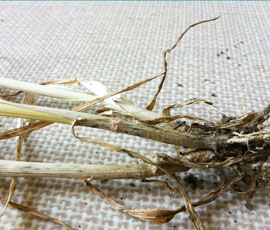Wheat foot rot takes advantage of dry season

An aggressive fusarium foot rot infection has killed a number of wheat plants in drought-stressed parts of the eastern counties.
The damage has been caused by the common Fusarium culmorum fungus, normally associated with ear blight. But because some crops have been subjected to significant drought stress, the fungus has been able to take hold, said Bill Clark, director of Broom’s Barn.
“It’s a phenomenon of drought. It only manifests itself under very high soil moisture deficits, which is why we are seeing it this season.”
The disease is more common in North America but is particularly rare for it to appear in UK, he said. “Under normal conditions, the fungus isn’t aggressive enough to kill the plant.”
Affected fields have scattered white heads and the symptoms can be mistaken for ear blight, take-all or eyespot, said Caroline Nicholls, assistant research and knowledge transfer manager for the HGCA. But the stem base appears water soaked and dark brown, while lower nodes can be pinkish under active sporulation.
There is no effective treatment this season, but growers should consider ploughing down trash if infections are severe to prevent build up of inoculum for next season, she suggested.
White heads in Robert Davidson’s wheat in Essex, which is suffering from the foot rot, range from 0-15%. “So it will affect our yield potential.”
Higher levels of infection appear to be on compacted headlands, he said, where there were more passes in wet drilling conditions.

